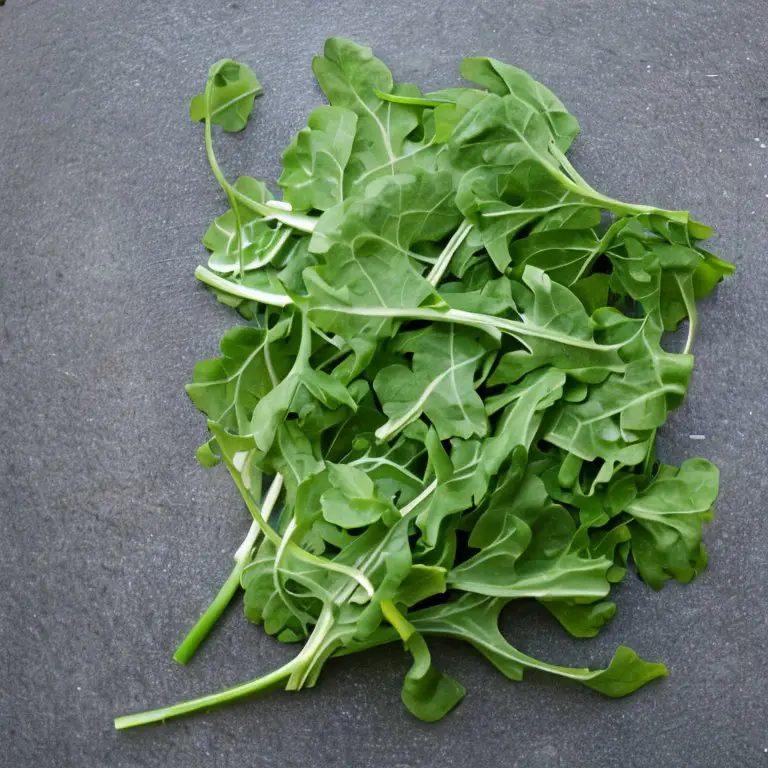Arugula, also known as rocket, is a leafy green vegetable that is commonly used in salads and other dishes. It is generally considered to be low in FODMAPs, which are short-chain carbohydrates that can be difficult for some people to digest. This makes arugula a good choice for people following a low-FODMAP diet to manage symptoms of irritable bowel syndrome (IBS) and other digestive disorders.
In this article, we will explore the potential benefits of including arugula in a low-FODMAP diet, as well as some ideas for incorporating it into your meals.
- What is Arugula?
- What are FODMAPs?
- What is the Low-FODMAP Diet?
- Is Arugula Low in FODMAPs?
- Benefits of Arugula
- How to Use Arugula on a Low-FODMAP Diet
- Is Arugula Bad for IBS?
What is Arugula?
Arugula, also known as rocket, is a leafy green vegetable that is commonly used in salads and other dishes. It is native to the Mediterranean region and has a slightly bitter and spicy flavor. Arugula has long, thin leaves that are dark green in color and have a slightly serrated edge. It is a good source of various nutrients, including vitamin K, vitamin C, and folate, as well as antioxidants.

Arugula is often used in salads and sandwiches, and can also be used in a variety of other dishes, such as pasta, pizza, and soups. It pairs well with a variety of ingredients, including fruits, vegetables, grains, and proteins.
What are FODMAPs?
FODMAP stands for “Fermentable Oligosaccharides, Disaccharides, Monosaccharides, and Polyols.” These are short-chain carbohydrates that are found in a wide variety of foods and can be difficult for some people to digest. FODMAPs are fermented by bacteria in the large intestine and can draw water into the intestine, leading to symptoms such as bloating, gas, abdominal pain, and diarrhea.
There are four main types of FODMAPs:
- Oligosaccharides: These include fructooligosaccharides (FOS) and galactooligosaccharides (GOS). They are found in certain types of vegetables, such as onions and garlic, as well as certain types of grains, such as wheat and rye.
- Disaccharides: These include lactose, which is found in milk and milk products.
- Monosaccharides: These include fructose, which is found in certain types of fruits, such as apples and pears, and honey.
- Polyols: These include sugar alcohols, such as mannitol and xylitol, which are found in certain types of fruits, vegetables, and sweeteners.
What is the Low-FODMAP Diet?
The low-FODMAP diet is a dietary approach that involves limiting foods that are high in FODMAPs in order to reduce the occurrence of digestive symptoms such as bloating, gas, abdominal pain, and diarrhea. The low-FODMAP diet is often recommended for people with irritable bowel syndrome (IBS) and other digestive disorders, as it has been shown to be effective in reducing symptoms in some individuals.
The low-FODMAP diet involves restricting high-FODMAP foods during the initial phase of the diet and gradually reintroducing them in a controlled manner to determine which foods trigger symptoms. Foods that are low in FODMAPs are generally allowed on the diet, while foods that are high in FODMAPs are generally restricted. Some examples of high-FODMAP foods include certain types of beans, wheat, onions, garlic, and certain types of fruits, such as apples and pears.
It is important to note that the low-FODMAP diet is not a long-term solution and should only be followed under the guidance of a healthcare provider or registered dietitian. The diet can be challenging to follow and may require significant lifestyle changes. It is also important to ensure that the diet is nutritionally adequate and provides all necessary nutrients.
Is Arugula Low in FODMAPs?
One serving of arugula (about 1 cup) is considered low in FODMAPs and should be well tolerated by most people following a low-FODMAP diet. However, it is important to note that everyone’s tolerance to FODMAPs is different and some people may still experience symptoms after consuming arugula. If you are following a low-FODMAP diet, it is always a good idea to speak with a healthcare provider or registered dietitian for personalized guidance.
Benefits of Arugula
In addition to being low in FODMAPs, arugula is also a good source of various nutrients, including vitamin K, vitamin C, and folate. It is also a good source of antioxidants, which are compounds that help to protect the body against damage from harmful substances called free radicals. Some studies have suggested that a diet rich in antioxidants may have a number of potential health benefits, including reducing the risk of certain chronic diseases such as cancer and heart disease.
How to Use Arugula on a Low-FODMAP Diet
Arugula can be enjoyed in a variety of dishes, such as salads, sandwiches, and pasta. It has a slightly bitter and spicy flavor that pairs well with a variety of ingredients. Some ideas for incorporating arugula into your diet include:
- Adding it to salads: Arugula makes a tasty and nutrient-rich addition to salads. Try pairing it with other low-FODMAP ingredients such as lettuce, tomatoes, cucumbers, and bell peppers.
- Using it as a sandwich filling: Arugula can add a spicy and refreshing flavor to sandwiches. Try pairing it with low-FODMAP protein sources such as chicken, turkey, or tofu, as well as low-FODMAP vegetables such as lettuce and tomatoes.
- Adding it to pasta dishes: Arugula can add a flavorful and nutrient-rich boost to pasta dishes. Try pairing it with low-FODMAP pasta and sauces, as well as low-FODMAP protein sources such as chicken, shrimp, or tofu.
- Using it as a pizza topping: Arugula can add a spicy and refreshing flavor to pizza. Try pairing it with low-FODMAP pizza crust and toppings such as chicken, vegetables, and cheese.
It is important to note that while arugula is generally considered to be low in FODMAPs, it is still important to be mindful of portion sizes when following a low FODMAP diet.
Is Arugula Bad for IBS?
Arugula, a type of leafy green vegetable, is not necessarily bad for IBS (irritable bowel syndrome), but it may trigger symptoms in some people with IBS. Arugula is a type of leafy green vegetable that is high in fiber, which can be beneficial for digestion. However, some people with IBS may find that high-fiber foods like arugula can cause bloating, gas, and other digestive symptoms.
If you have IBS and are considering adding arugula to your diet, it may be helpful to start with a small amount and see how your body reacts. If you experience symptoms after eating arugula, you may want to limit your intake or avoid it altogether. It’s also important to note that everyone is different and what may trigger symptoms in one person with IBS may not have the same effect on another person.
Lance has been passionate about the plant-based diet and we have been following a whole food plant-based diet for over 5 years. We focus on health, natural healing, weight management, animal rights, and the health of the planet and environment by focusing on whole plant-based foods and sustainable practices.
Learn more at the About Me page and follow on social media at the links below.







